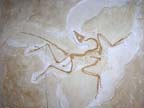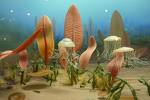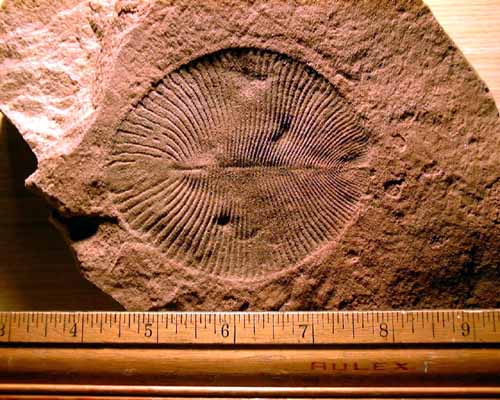 |
 |
 |
 |
 |
Produced
by the Population Genetics and Evolution class, Furman University |
||||
 |
 |
 |
 |
 |
Produced
by the Population Genetics and Evolution class, Furman University |
||||
 |
The
Ediacaran: Dickinsonia |
 |
The Precambrian
fossil known as Dickinsonia dates back as far as 600 million
years ago, and can be found in regions of Russia and Australia (Virtual
Fossil Museum). Many of these fossil’s indentations are found
in various rocky structures such as sandstone and can range in length
to over a meter. The structure and classification of the Dickinsonia
organisms are still debated among scientist today because of their shared
characteristics with Annelids, Cnidarians, and other organisms (Antcliffe
and McLoughlin 2008). These fossils display bilateral symmetry due to
the extension of what appears to be segmented structures that extend
out from a central line. These organisms had very primitive circulation
systems, digestive tracts and even muscles in between all their segments
that allowed them to dig into sandy or muddy surfaces, which possibly
caused the perfect preservation of these extinct organisms (Runnegar
1982). The structures in some fossils found in Russia and Australia
differ in shape and size; however the same overall shape and composition
remain intact in all Dickinsonia fossils. Page by Pete Calomiris |
 |
| Dickinsonia. Photo credit: University of California Museum of Paleontology | |
|
Antcliffe, J. and N. McLoughlin, N. 2008. Deciphering the fossil evidence for the Origins of Life, Origins of Animals: Common problems in different worlds. In "From Fossils to Astrobiology" M. Walsh and J. Sekbach (Eds) Springer, 211-229. Runnegar, B. 1982. Oxygen requirements, biology and phylogenetic significance of the late Precambrian worm Dickinsonia, and the evolution of the burrowing habit. Alcheringa 6-3: 223-239. The Virtual Fossil Museum. Dickinsonia Vendian Fossil. Accessed Januray 2010. |